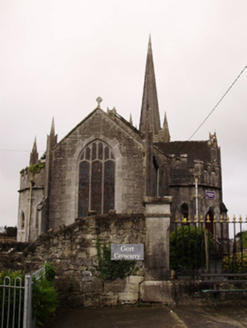Survey Data
Reg No
30341042
Rating
Regional
Categories of Special Interest
Architectural, Artistic, Historical, Social
Previous Name
Saint Colman's Church (Kilmacduagh)
Original Use
Church/chapel
In Use As
Library/archive
Date
1805 - 1815
Coordinates
145082, 201900
Date Recorded
22/09/2009
Date Updated
--/--/--
Description
Freestanding cruciform-plan limestone former Church of Ireland church, built c.1810, with two-bay nave, three-stage tower to west gable, full-height transepts, and lower chancel to east elevation, with crenellated canted porch to north re-entrant corner of chancel and nave and similar annex to south. Now in use as library. Pitched slate roofs with cut-stone copings, tower having spire and crenellations. Crenellations also to porch and annex, cut-stone finials and cross finials to gables, corner pinnacles and cast-iron rainwater goods. Dressed walls with stepped corner buttresses, and having cut-stone string courses to tower. Pointed arch stained-glass three-light window to east gable with cut limestone block-and-start surround. Pointed arch louvered openings to top stage of tower. Pointed arch window openings elsewhere with replacement windows. Pointed arch door openings to porch and south side of tower with chamfered limestone block-and-start surrounds and timber battened doors with cut limestone steps. Graveyard to south incorporating former convent orchard. Double-leaf cast-iron gate, flanked by ashlar limestone piers with chamfered edges, limestone plinth wall with cast-iron railings. Set within its own grounds.
Appraisal
Attributed to architect, James Pain, this former church is notable for the fine craftsmanship visible throughout, particularly in the stone carving to the pinnacles, crenellations and string courses. The remaining stained-glass window, provided by Sibthorpe of Dublin by gift of Mrs Lahiff, adds artistic interest. The building continues to hold a social function as a library for the townspeople of Gort. Originally funded by a loan of £1400 by the Board of First Fruits, it was, like the Catholic church in the town, built on a site donated by Lord Gort. Queen Street was laid out subsequent to its construction, to allow it to be viewed to best advantage.











